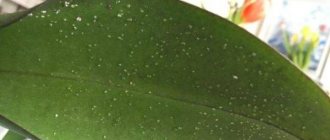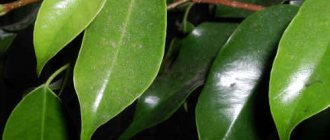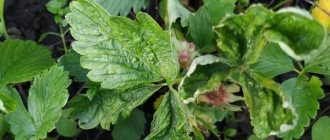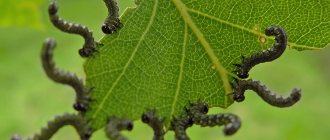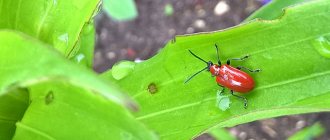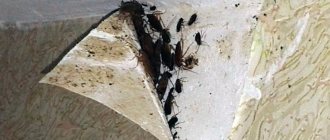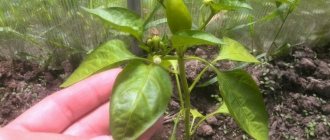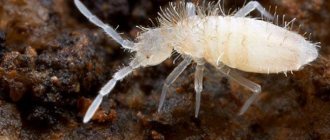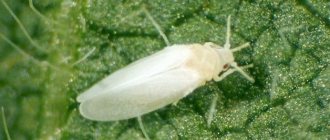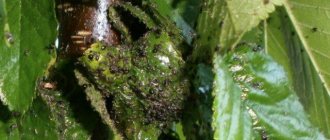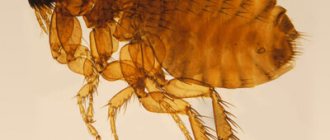Ficus diseases
Ficus can be affected by fungal or infectious diseases.
Important! If any spots appear on the leaves of Ficus Benjamin or the leaf plates begin to rot, then you should immediately determine the cause and begin to eliminate it.
The following diseases are dangerous for ficus trees:
- Mold or gray mold. The disease is characterized by the appearance of brown spots on the leaves and stem. Over time, leaf fall begins. It is not difficult to recognize mold, because if you shake the plant a little, you will notice an uncharacteristic (gray) dust in the air. Considering that the fungus lives in a damp and warm room, you can get rid of it by lowering the temperature and increasing the humidity.
- Sooty mushroom. If Benjamin's ficus has sticky leaves, it means that it is affected by this particular disease. Moreover, its harbingers were scale insects and aphids, which left sticky leaves on which a sooty fungus developed.
- Root rot. In this case, there is no stickiness, but dark spots appear on the leaves and they wither. The trunk may begin to rot. If the roots are completely rotten, the flower is thrown away.
- Powdery mildew. It is not difficult to identify this disease, since white dots resembling flour appear on the leaves. To solve the problem, you need to remove all affected leaves.
- Cercospora blight. This is a fungal disease that occurs due to excessive humidity in the room. In this case, the lower part of the leaf blades is covered with brown spots and dots.
- Fungus Anthracnose and Botrytis. These diseases are very similar to each other. In the first case, the spots on the leaves resemble rust, in the second, the spots are yellow-brown in color.
Important! The mistake many gardeners make is that they wait until the leaves completely fall off and the trunk no longer resembles anything. The issue needs to be resolved quickly and radically.
Why is it dangerous for indoor plants?
The danger of sticky plaque for indoor flowers is as follows:
- by releasing juice, the plant loses nutrients and moisture;
- sticky coating prevents the evaporation of excess moisture from the leaves and its entry along with nutrients to the above-ground parts of the plant;
- the process of photosynthesis is disrupted, which is why the leaves turn yellow and fall off over time;
- The sticky and sweet sap serves as a breeding ground for the development of bacteria that can harm the plant.
Therefore, the appearance of a sticky coating is an alarming sign in which the plant must be urgently examined for the presence of pests.
Fungal infections
Gray rot or Botrytis: appears in flowers kept in a warm room with high humidity.
The ficus is covered in places with a gray coating. When shaken, dust rises up. The leaves begin to darken and then die.
To eliminate the disease, remove all affected areas of the flower and allow the soil to dry. Next, regulate watering and ensure frequent ventilation.
Sooty fungus: appears on the surface as a black coating. The precursor to the disease is the secretions of insect pests.
For small affected areas, treat them with soapy water, passing a sponge over each one separately. Severely affected units are removed and destroyed, and the stems and roots are sprayed with fungicide.
Pythium, late blight, rhizoctonia: fungi provoke rotting of roots and stems. The plant stops growing and gradually dies. It will not be possible to save it; it must be eliminated before other flowers become infected.
For prevention, moderate watering is needed, once a month with a weak solution of manganese.
Powdery mildew: appears as white powdery spots. Its appearance is provoked by high humidity and heat. For treatment, spray with a solution of copper sulfate and soda ash: dilute 10 g of soda, 2 g of laundry soap in a liter of water, stir 2 g of sulfate separately, pour the mixture into the main composition. Bring the volume to 2 liters and spray with it.
Rust (anthracosis): expressed by spreading yellow-brown spots, the edges of the leaves look burned, sometimes pitted with ulcers. To get rid of it, the plant is cleaned of affected areas and treated with a fungicide.
Advice! To make an accurate diagnosis, it is better to compare the identified signs of ficus disease with photographs, and then their treatment will be more productive, and other flowers will be protected from infection.
- Spider mite. The presence is indicated by spots of a gray or brown tint, and in places a thin cobweb may be visible. The environment for development is dry and warm, this promotes rapid reproduction. Leaves damaged by it dry out and fall off. To avoid damage to the ficus, optimal humidity should be maintained in the room, the plant should be sprayed with water, and occasionally wiped with a solution of laundry soap. If affected, treat with an insecticide.
- Aphid. The appearance of a sticky coating, yellowing and deformation of leaves is the result of aphid parasitism. Insect secretions become a breeding ground for fungal infections, which will lead to the destruction of the flower. Treatment with soapy water and insecticides will help.
- Thrips. Small black bugs. They settle on the back side of leaves and drink plant sap. Infestation appears as brown, white and yellow spots. To get rid of the pest, they are treated with the following drugs: Actillic, Tanrek, Aktara.
- Mealybug. Appears as white lumps. It can be found both on the plant itself and on the soil around it, quickly moving to nearby flowers. For treatment, insects are removed from the ficus and treated with tobacco or soap solution once a week. In advanced cases, Confidor is used, treatment is carried out twice every 10 days.
- Nematodes. Small bead-like growths on the roots. They release toxins that cause the ficus to become faded and die if not treated in a timely manner. This requires replanting into new soil, with preliminary soaking of the roots in an insecticide solution for 3 hours.
Why is there a problem with the Benjamin variety?
Reference. Most often, the cause of the appearance of a sticky layer on the leaves of Ficus Benjamin is due to pest attacks.
Let us consider the signs of the appearance of each parasite separately in order to recognize them in time and begin treatment of the plant.
Spider mite
It will not be easy to see this pest with the naked eye. First of all, pay attention to the leaf plates - they are covered with small white dots. The rest of the ground part of the ficus is covered with a thin web. In this case the flower:
- slows down development;
- deformed;
- loses decorative properties;
- turn yellow;
- then it dries out;
- completely dies.
One parasite lives only 45 days, but during this period it manages to lay up to 1000 eggs. The eggs become full-fledged individuals after 3 days. Favorable conditions for spider mites are high air temperatures and low humidity.
Important! Parasites feed on ficus sap. In their habitat, the leaves immediately turn yellow. When weakened plants die, mites move to neighboring crops.
Shchitovka
These are chestnut or gray parasites with an oval shape. Scale insects are easy to pick up even with a needle.
- The first sign of the appearance of scale insects is a sticky layer on the surface of the leaves. The sticky layer is a natural secretion of pests, which contains a lot of sugar. Subsequently, a fungus develops on the sticky layer, which leads to the death of the plant.
- The second sure sign of scale insect damage is the appearance of gray or brown growths over the entire ground surface of the flower.
- The next sign is deformation of the leaf plate and the growth of tubercles on them.
Attention! If left untreated, the leaves die first, and then the entire crop dies.
Mealybug
The mealybug is a relatively large pest. Its length reaches 5 mm. The body shape is oval. Distinctive features are a white coating and bristles on the sides. The color of the worm can be different:
- pink;
- cream;
- brown.
There are characteristic stripes (transverse) on the back of the pest.
Reference. The life cycle of males is short. But females are protected from chemicals by a special wax layer. Only females and their larvae cause damage to the plant, and males do not feed on ficus juice.
The first sign of a mealybug attack is white cocoons on the surface of the crop, as well as streaks of white juice.
Aphid
When a ficus is infested with aphids, the foliage turns yellow and curls. The plates then become sticky to the touch and shiny in appearance. These pests live in numerous colonies and are able to fly from one plant to another.
Important! Aphids live mainly on the lower part of the plant. They are easy to notice due to the large cluster on one leaf.
Thrips
Thrips can also cause the sticky coating. It is difficult to notice them on Benjamin foliage. This is due to the color of the pests - they are usually gray, black or brown.
In appearance, thrips resemble very small flies. They settle on ficus in large colonies. The main food for thrips is plant sap. Due to its sucking, the culture stops growing.
The described pests are carriers of a large number of viruses. In addition, the sticky layer attracts fungus.
Attention! After the loss of juice, black dead spots appear on the surface of the flower. Also, the attack of thrips is characterized by deformation of leaf plates and the appearance of an openwork mesh on them. Sometimes yellow or silvery spots can be seen.
Nematodes
These pests attack the root system, causing growths that look like small beads to appear on parts of it. Toxins that enter the roots spread throughout the plant. Because of this, the ficus becomes pale and then dies.
Reference. The development of nematodes is favored by high humidity and air temperature.
Methods for treating fungal diseases
Fungal diseases can be treated in several ways.
- Spraying with fungicides. If simple methods (changing temperature, air humidity, etc.) do not help, then move on to fungicides. Spraying a flower with a solution makes it possible to get rid of almost all fungal infections.
- Trimming. Pruning is often carried out when fungicides can be dispensed with or they have not had the desired effect. This method is especially relevant for root rot, when some roots can still be saved. In this case, the ficus is taken out of the pot and the root system is carefully examined. Rotten roots are cut off and thrown away, and after that the plant is transplanted into new soil and a new flowerpot.
- Folk remedies. This technique is good when the disease has just made itself felt. In this case, the flower can be treated with soapy water, garlic or alcohol.
Common problems
If you do not comply with the growing conditions, then the ficus will not look healthy. It is not necessary that the bush is affected by insects or disease; sometimes the problem is due to insufficient lighting. Pale and yellowing of the leaves indicates a lack of the required amount of light. In this case, you just need to move the pot closer to the window, and in winter add artificial lighting.
The appearance of brown spots is a sign of a burn from direct sunlight.
It also happens that the falling of leaves and the appearance of blackening are the result of frostbite on the plant. You can revive the plant at home. The most important thing is to eliminate the source of the draft and create conditions for resuscitation. Under no circumstances should you water the flower; you need to wait until the soil dries well. The necessary moisture is provided by spraying the foliage with warm and settled water. As soon as new shoots appear, it is possible to resume watering and use Kornevin, a growth activator. "Orton Growth" is used as a top dressing 2 times every week.
If the flower dries out or has already dried up, then you need to restore it immediately. To do this, use high-quality watering and a lot of diffused light in combination with stimulants. The root system is freed from the soil and placed in water, waiting for new shoots to appear.
Ficus benjamina has sticky leaves, what is this disease?
Ficus benjamina has sticky leaves, what is this disease?
It looks like a scale insect. I can offer you 2 options for dealing with it: the Aktara product, and you can not only spray the plant, but also water it. Just look, think about how to do this if there are children and pets in the house. But my mother got rid of scale insects in winter by simply watering the plant with actara. And the second method helps, but may not completely get rid of it if the pest is in the ground. You need to wipe the leaves with pure alcohol applied to cotton wool. Only with pure alcohol - never vodka! and don’t be overzealous—it’s enough to swipe it once with a cotton swab. The alcohol evaporates quickly and only the scale insects have time to burn, while vodka will burn the plant! Good luck!
Hello, Marinochka. Of course, in connection with the summer season and the onset of summer, you naturally want to grow a healthy and excellent harvest. If Ficus Benjamin has sticky leaves, then this is definitely a disease called “scale insects,” which affects the leaves with tubercles or spots. You can fight it only thanks to a remedy called “Aktara”. There is simply no point in using some kind of folk remedies, since this will be an absolutely ineffective method of struggle.
This pest is a scale insect that loves to attack indoor plants. The degree of damage varies; if it is very severe, the plant cannot be saved. The action of scale insects resembles aphids - both pests feed on plant juices. The scale insect is difficult to destroy mechanically, since it is tightly attached to the leaf, and small scale insects (young individuals) are generally translucent, they are almost invisible.
Naturally, scale insects on indoor plants must be combated. The most important thing to remember is that one procedure is usually not enough; you need to repeat the treatment three times. Insect repellents (insecticides) are effective, the best of them is “Aktara”, but others can be used,
If there are few scale insects, then you can try to carefully remove it mechanically, trying not to damage the plants, wash them with a strong solution of green liquid soap, then with water under a warm shower, repeating this procedure a week later.
Causes of the disease
Sometimes ficus trees can develop various kinds of diseases. They usually occur due to improper or negligent care. Pests emerge from contaminated soil, quickly attacking the roots and destroying the plant. Or the flower may freeze and die from fungi and other related infections.
The main causes of ficus diseases:
- temperature imbalance;
- excess or deficiency of air humidity;
- untimely or frequent watering;
- lack or oversaturation of essential microelements.
Ficus is never placed near a heating radiator. If heating devices are located nearby, then a moistened cloth is placed on them and on the windowsill for protection, and the surface of the flower is often sprayed with small drops. If the humidity, on the contrary, is high, then it is advisable to wait until the soil dries 2-3 cm, and then continue watering.
You should beware of extreme heat and excessively dry air, strong drafts and gusts of wind. You cannot spray ficus and then place it in the sun - you can cause the leaves to burn.
If the grower takes diligent care of the plant, then the risk of disease is minimized. However, sometimes cuttings and young stems may have hidden diseases that are not noticeable at first glance. Infections and parasites (for example, nematodes) are introduced from the soil. Ficus often dies from them.
It is recommended to fertilize ficus in the warm season - once every two weeks. With the onset of autumn, they feed less often; in winter there is no need to touch the flower. Nourish the soil according to the instructions on the package so as not to overfeed. The leaves also react to excess feeding - dots and specks appear on them.
If rot appears at the base of the root, the leaves wither and curl, the culprit is most likely constant flooding. If the ficus stops growing, the soil is depleted and mineral resources are running out.
Harmful insects
Some plants are better equipped to handle pests, while others need a little extra help. Before purchasing a ficus tree, it is important to research what problems are common with these beautiful trees.
- Mealybug. They are small white furry sucking insects that gather in large clusters. They may appear after watering as they crawl to the surface of the soil. They can be seen in areas of the plant where branches meet the main stem. There are several ways to treat insects. You can spray the foliage with horticultural oil or treat the soil with chemicals. If you don’t want to use chemicals, then spray a soap solution. The liquid is prepared at the rate of 1 tablespoon of soap per 4.5 liters of water.
- Centipedes. These are brown insects with a long body and many legs. If they appear, it is likely that the soil was not sterilized before the tree was planted in it. The best way to combat this problem is to change the soil and sterilize the new one. The pot should also be cleaned - this is the only way to ensure that the grower is free of pests.
- Shield. Like other insects, scale insects do not tolerate high humidity and soapy treatment. Saving a plant from it is not difficult, you just need to spend a little time on processing.
- Thrips. This is an insect that is difficult to get rid of and even more difficult to see because it is so small. You can inspect the foliage for the appearance of small dark spots, that is, waste that they leave on the ficus. To get rid of them, you first need to water the plant from the shower, then spray it with neem oil.
- Whiteflies . They often attack the flower. They immediately become visible due to their white coating. To prevent their occurrence, it is necessary to use neem oil sprays. Standard yellow sticky traps also work well.
- Spider mites. You can get rid of them with a simple soap solution or a strong shower.
- Aphid . When branches and leaves curl, this may be a sign that aphids have appeared, which, in turn, are also carriers of bacterial diseases. They get rid of it with an alcohol solution, which needs to be used to wipe the trunk and leaves.
Chemical treatments
Spraying with potent drugs is especially important during the period of the emergence of new generations of scale insects. Immediately after birth they are most vulnerable, so there is a high chance of death after the first treatment. At the same time, adult individuals can remain undamaged thanks to a special shell on their back, so a set of measures will have to be carried out to obtain a lasting positive result.
Important!
The principle of operation of the drugs is not only in contact with insects, but also in absorption by leaves and flowers. Entering the sap of the plant, they kill pests in the process of their vital activity, so their death is inevitable, it simply depends on the prevalence of the population and its generation.
Preparations with a high oil content have proven themselves in practice. They kill mealybugs, but can be dangerous to healthy parts of indoor plants, so experts recommend treating only those parts where the insects are clearly active (see photo).
( 2 ratings, average 4.5 out of 5 )
LiveInternetLiveInternet
-Music
—Categories
- health (1262)
- knitting (1207)
- crochet (897)
- tips (795)
- jokes (742)
- sewing (650)
- 1-course (628)
- health (606)
- salads (599)
- knitting for home (543)
- plants (530)
- poems (462)
- pies (445)
- this is interesting (405)
- pies (395)
- blanks (372)
- knitting (358)
- elm hats (352)
- music (351)
- handicrafts (324)
- proverbs (282)
- bird (274)
- questions (269)
- vegetable dishes (269)
- crayfish fish (261)
- cakes (246)
- meat dishes (236)
- Remstroy (227)
- knitting for children (226)
- elm collars (204)
- cooking tips (201)
- dessert (199)
- aaan news (193)
- education (181)
- hair (172)
- casseroles (168)
- embroidery (161)
- dough (161)
- spirituality (159)
- Easter cakes (154)
- cocktail drinks (154)
- snacks (144)
- cookies (139)
- elm flowers (137)
- history (136)
- buns (131)
- cupcakes (131)
- pancakes (128)
- politics (127)
- elm scarves (126)
- elm borders (125)
- sauces (125)
- ice cream (125)
- new year (120)
- minced meat dishes (119)
- jellied pies (118)
- photoshop (111)
- English (107)
- lyru textbook (105)
- elm motifs (104)
- videos (103)
- zucchini (100)
- lean (99)
- knitting dresses (99)
- elm vests (98)
- pizza (98)
- audiobooks (95)
- knitted skirts (91)
- elm slippers (84)
- charlotte (83)
- cabbage pancakes (79)
- puff pastries (77)
- lavash (76)
- microwave (74)
- knitted tops (74)
- salt fish (74)
- bread (74)
- elm poncho (72)
- knitting video tutorials (72)
- elm bibs (71)
- elm jacket (71)
- elm pullover (70)
- generator (69)
- postcards (66)
- eggplant (64)
- diary (63)
- biscuit (62)
- text generator (61)
- dumplings (61)
- porridge (56)
- elm bags (55)
- cream (54)
- lessons (54)
- action games (54)
- cheesecakes, pancakes (54)
- pancakes (53)
- keys (53)
- rolls (52)
- elm decorations (51)
- paintings (51)
- liver (51)
- spices (51)
- reading (46)
- spelling (45)
- woven newspapers (43)
- mushrooms (42)
- children (41)
- napoleon (40)
- kebabs (39)
- elm shawls (38)
- elm tunics (38)
- cord elm (36)
- Internet guide (36)
- eggs (35)
- cabbage rolls (35)
- brushwood (34)
- cakes (34)
- omelettes (34)
- sandwiches (32)
- lard (31)
- pumpkin (31)
- spices (30)
- applique (30)
- patchwork (30)
- etiquette (29)
- masks (28)
- dumplings (27)
- pasties (26)
- pilaf (26)
- no bake (24)
- chains (24)
- programs (24)
- organizer (22)
- khachapuri (22)
- cinema (22)
- watch (21)
- mayonnaise (21)
- aspic (21)
- music (20)
- animations (20)
- friends (19)
- eggplant (19)
- adjika (18)
- drawings (17)
- frames (17)
- beans (17)
- meatballs (16)
- write beautifully (16)
- strudel (15)
- dictionaries (15)
- herring (15)
- interesting sites (14)
- whites (14)
- pate (14)
- elm fur (13)
- collars (13)
- elm bolero (12)
- Solyanka (12)
- movies (11)
- pancakes with meat (11)
- casseroles (11)
- Irish elm (10)
- julienne (10)
- boiled pork (10)
- minced peppers (10)
- rabbit (10)
- croutons (9)
- elm sweaters (9)
- cheese (9)
- clipart (9)
- elm coat (8)
- newspaper weaving (8)
- forshmak (7)
- Windows (7)
- pearl barley (7)
- blog (7)
- news (7)
- elm swimwear (6)
- chippers (6)
- tongue (6)
- antivirus (6)
- origami (6)
- buttons (6)
- pudding (6)
- vinaigrette (5)
- emoticons (5)
- calendar (5)
- soufflé (5)
- glaze (5)
- translator (5)
- filter plugins (5)
- desktop (5)
- jelly (4)
- gooseberry (4)
- aspic (4)
- eclairs (4)
- encyclopedias (4)
- fillings (4)
- kvass (4)
- government services (4)
- banners (3)
- bad news (3)
- shawarma (3)
- calculators (3)
- applied arts (2)
- needle elm (2)
- greeting (2)
- security (2)
- Yandex disk (2)
- chips (2)
- president of russia (2)
- flash material (2)
- sports (2)
- karaoke (2)
- corn (2)
- puff pastry (2)
- kidneys (2)
- tags (2)
- strudli (1)
- diction (1)
- strawberry (1)
- cucumbers (1)
- elm alphabet (1)
- Windows commands (1)
- elm mittens (1)
- cutlets (1)
- juices (1)
- Irish lace (1)
- elm silk thread (1)
- finance (1)
- fricassee (1)
- folk (1)
- flash card (1)
- link shortener (1)
- games (1)
- performances (1)
- search engines (1)
- thermal box (1)
- Media (1)
- cache, cookies (1)
- children's dictionary (0)
- search engine "Sputnik" (0)
- knitting collar (0)
- (0)
- [flash=500,500,https://www.yapfiles.ru/files/843981 (0)
- cliparts (0)
- patchwork (0)
- Chebcracks (0)
- Christmas kutia (0)
- dessert (0)
Ficus diseases
Ficus can be affected by fungal or infectious diseases.
Important! If any spots appear on the leaves of Ficus Benjamin or the leaf plates begin to rot, then you should immediately determine the cause and begin to eliminate it.
The following diseases are dangerous for ficus trees:
- Mold or gray mold. The disease is characterized by the appearance of brown spots on the leaves and stem. Over time, leaf fall begins. It is not difficult to recognize mold, because if you shake the plant a little, you will notice an uncharacteristic (gray) dust in the air. Considering that the fungus lives in a damp and warm room, you can get rid of it by lowering the temperature and increasing the humidity.
- Sooty mushroom. If Benjamin's ficus has sticky leaves, it means that it is affected by this particular disease. Moreover, its harbingers were scale insects and aphids, which left sticky leaves on which a sooty fungus developed.
- Root rot. In this case, there is no stickiness, but dark spots appear on the leaves and they wither. The trunk may begin to rot. If the roots are completely rotten, the flower is thrown away.
- Powdery mildew. It is not difficult to identify this disease, since white dots resembling flour appear on the leaves. To solve the problem, you need to remove all affected leaves.
- Cercospora blight. This is a fungal disease that occurs due to excessive humidity in the room. In this case, the lower part of the leaf blades is covered with brown spots and dots.
- Fungus Anthracnose and Botrytis. These diseases are very similar to each other. In the first case, the spots on the leaves resemble rust, in the second, the spots are yellow-brown in color.
Methods for treating fungal diseases
Fungal diseases can be treated in several ways.
- Spraying with fungicides. If simple methods (changing temperature, air humidity, etc.) do not help, then move on to fungicides. Spraying a flower with a solution makes it possible to get rid of almost all fungal infections.
- Trimming. Pruning is often carried out when fungicides can be dispensed with or they have not had the desired effect. This method is especially relevant for root rot, when some roots can still be saved. In this case, the ficus is taken out of the pot and the root system is carefully examined. Rotten roots are cut off and thrown away, and after that the plant is transplanted into new soil and a new flowerpot.
- Folk remedies. This technique is good when the disease has just made itself felt. In this case, the flower can be treated with soapy water, garlic or alcohol.
What to do and how to deal with pests?
- To get rid of spider mites, it is enough to use acaricides. The most common and effective are Actellik, Vermitek and Flumite. Breed them according to the instructions. To completely destroy the tick, you will need 2-3 treatments with an interval of 5-7 days.
- To combat scale insects, you can use a mechanical method. It consists of wiping the surface of the ficus with a sponge (or soft brush) dipped in a soap solution. But here it is worth considering that even one remaining larva will multiply and create a new colony. To destroy scale insect larvae, the plant is treated with an insecticide. In this case, it is better to use contact preparations, since they do not penetrate the plant tissue and are easily washed off with water. This will also require three treatments at weekly intervals. The place where the pot stands should be wiped with a cloth soaked in alcohol.
- To get rid of mealybugs once and for all, you need to use chemicals (insecticides). They are available in the form of sprays, liquid for dilution, granules and sticks for placement in the soil, as well as oil formulations. You can use folk remedies. One option is an alcohol solution (mix 10 ml of liquid soap and the same amount of alcohol, dilute it all in a liter of water). Another good product based on olive oil. To prepare it, dilute 2 tablespoons of olive oil in a liter of warm water.
- Any insecticide will help against aphids Prepare it according to the instructions. Bordeaux mixture or soap solution also helps a lot (it is advisable to use laundry soap).
- Thrips are killed with the same insecticides that kill spider mites. After treatment with Actellik, the plant is covered with polyethylene for a day. The same should be done when spraying with Fitoverm. When using Agrovertin, you need to ensure the room is warm.
- When fighting nematodes, the insecticides listed above are used. And be sure to change the soil and disinfect the pot.
Pest control must be started immediately in order to save the plant. At the first signs of damage, you need to isolate the ficus from other crops.
Source
